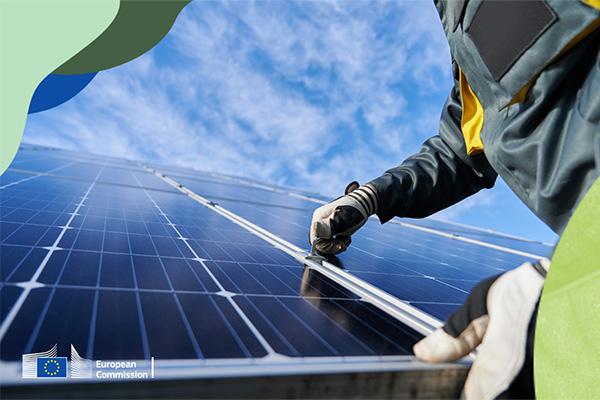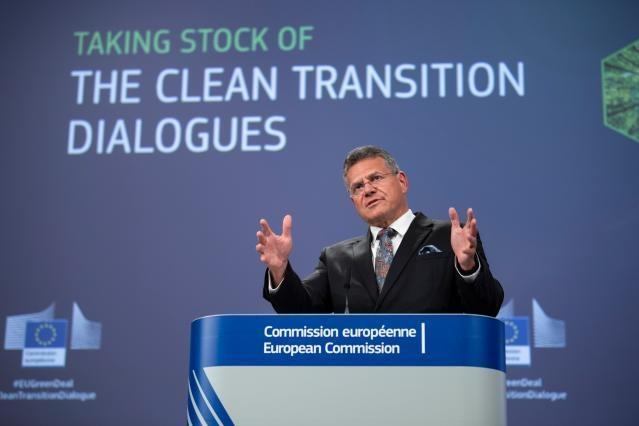Building up Europe's capacity to produce and use clean energy is essential to ensuring that the EU remains competitive on the global clean energy technology market, bringing benefits to the European economy and citizens.
The EU is currently facing technological and non-technological challenges, such as high energy prices, critical raw materials supply chain disruptions and skills shortages. Strengthening the competitiveness of the EU clean energy sector will help shape a more resilient, independent, secure and affordable energy system in Europe.
Considering that half of the greenhouse gas emission reductions expected by 2050 require technologies that are not yet ready for the market, research and innovation activities are crucial to supply the technologies needed for the green and digital energy transition and to deliver on the European Green Deal and REPowerEU objectives.
Competitiveness progress reports
Since 2020, the Commission has published yearly progress reports on the competitiveness of clean energy technologies, presenting the current and projected state of play. They also map the research, innovation and competitiveness aspects of the EU’s clean energy system as a whole, with the aim of informing policy decisions and helping to make the EU competitive, resilient and climate-neutral by 2050.
The 2023 Competitiveness Progress Report aims to monitor the competitiveness of the EU’s clean energy and net-zero technology sectors.
It builds on available data to provide insights into ways of reinforcing the EU’s competitiveness in clean energy technology.
It also highlights the main drivers, opportunities and barriers, including challenges such as energy and material costs, value chain resilience, labour shortages and innovation.

The report shows how the cost of clean energy technologies remained highly competitive in 2022, despite rising energy and materials costs, leading to an increase of around 50% in the rate of wind and solar roll-out across the EU, compared to the previous year.
It includes dedicated sections assessing the competitiveness of strategic energy technologies outlined in the Net-Zero Industry Act proposal, namely solar PV, solar thermal, onshore and offshore wind, ocean energy, batteries, heat pumps, geothermal energy, water electrolysis to produce renewable hydrogen, sustainable biogas and biomethane, carbon capture and storage and grid technologies.
This progress report is published in accordance with Article 35 of the Governance Regulation (EU/2018/1999) and accompanies the State of the Energy Union report.
Policy factsheets are available covering the main recommendations for the technologies covered in the 2023 Competitiveness Progress Report, as well as technology factsheets which cover both Competitive Progress Report and Clean Energy Technology Observatory technologies.
Clean Transition Dialogues
Commission President von der Leyen announced the launch of the Clean Transition Dialogues in her 2023 State of the Union speech, to discuss with European industry and social partners how to strengthen and support the implementation of the European Green Deal, contributing to a reinforced industrial approach.
Executive Vice-President Maroš Šefčovič chaired 9 dialogues between October 2023 and March 2024 covering hydrogen, energy-intensive industries, clean tech, energy infrastructure, critical raw materials, forest-based bioeconomy, cities, clean mobility, and steel. The Commission presented a Communication taking stock of the dialogues in April 2024, confirming that industry and social partners are committed to shaping and implementing the Green Deal.

The Net-Zero Industry Act
The Net-Zero Industry Act (Regulation 2024/1735) was published and entered into force in June 2024 and is part of Europe’s Green Deal Industrial Plan.
The Act aims to strengthen the resilience and competitiveness of net-zero technologies in the EU, by making our energy system more secure, sustainable and affordable. It will create the right conditions to attract investments, support innovation (including through regulatory sandboxes) and ensure that at least 40% of the EU’s annual deployment needs for net-zero technologies are manufactured in the EU. It provides an EU roadmap to reduce Europe’s high dependency on imports from China and other single suppliers of net-zero technologies. It will also help increase resilience in Europe’s clean energy supply chains by avoiding the disruption in global energy market supply chains brought about by Russia’s invasion of Ukraine, which in turn accelerated Europe’s transition away from Russian fossil fuels.
The Clean Energy Technology Observatory
The Commission has set up the Clean Energy Technology Observatory (CETO), a shared initiative between the Commission’s Joint Research Centre, the Directorate-General for Research and Innovation, and the Directorate-General for Energy.
Since 2022, the observatory, which builds on the Low Carbon Energy Observatory, is monitoring EU research and innovation on clean energy technologies. One of its main goals is to provide a repository of technological and socio-economic data on the most relevant technologies and their integration in the energy system. It targets in particular the status and outlook for innovative solutions and the sustainable market uptake of both mature and inventive technologies.
CETO produces a series of annual reports addressing technology maturity status, development and trends (2030-2050 and beyond), value chain analysis, global market and EU positioning, along with clean technology system integration. These reports provide the evidence-based analysis underpinning the Progress Report on Competitiveness of Clean Energy Technologies and support the implementation of the SET Plan and research policy development.
Documents
- 25 JULY 2023
- 2023 Progress report on competitiveness of clean energy technologies (COM/2023/652)
- 2022 Progress Report on competitiveness of clean energy technologies (COM/2022/643)
- 2021 Progress Report on competitiveness of clean energy technologies (COM/2021/952) and its five staff working documents (SWD (2021/307)
- 2020 Progress report on competitiveness of clean energy technologies (COM(2020/953)
- Technology factsheet: Competitiveness of clean energy technology
- Policy brief: Competitiveness of clean energy technology
- Webinar: 2023 Competitiveness Progress Report: net zero solutions for a clean, fair and resilient energy system
- ENTEC Report on supply chain risks in the EU’s clean energy technologies (October 2023)
- ENTEC Study on regulatory sandboxes in the energy sector (July 2023)
- Clean energy transition - technologies and innovations, accompanying the report on progress of clean energy competitiveness (SWD (2020) 953)
- Energy union and the Eighth Report on the State of the Energy Union
- Clean Energy Industrial Forum
- Clean Energy Technology Observatory
- Strategic Energy Technology (SET) Plan
